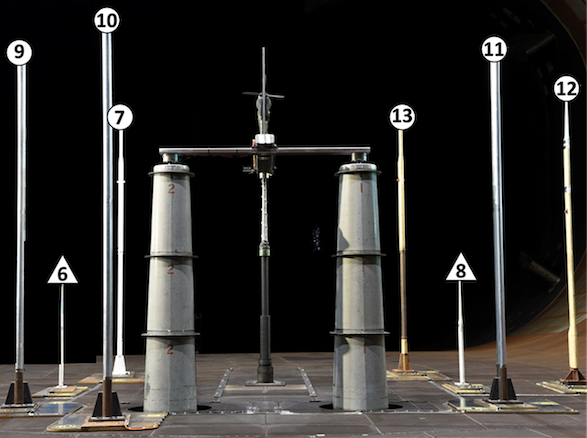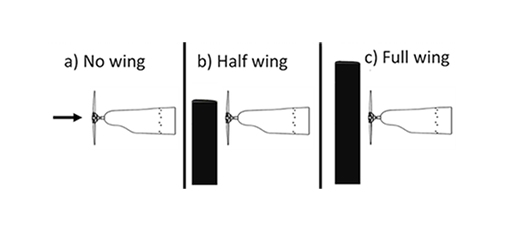THE AERODYNAMIC AND ACOUSTIC ROTORPROP TEST (AART) PROGRAM
Unmanned Aerial Vehicles (UAV) and Urban Air Mobility (UAM) designs experience complex aerodynamic and acoustic conditions, such as crosswinds and wing/propeller interactions. Current open-access acoustic databases don’t include configurations representative of current UAV and UAM designs. To observe and investigate these conditions, the U.S. Army and Sikorsky introduced the Aerodynamic and Acoustic Rotorprop Test (AART) program. With the support of NASA, the AART stand was tested in the National Full–Scale Aerodynamics Complex (NFAC) 40– by 80–Foot Wind Tunnel from 2019–2020.
The primary objective of the AART program was to determine the aerodynamics and acoustics related to an auxiliary propulsor mounted behind an isolated wing in the NFAC 40–by 80–Foot Wind Tunnel, see figure 1. Acquired measurements could then be used to validate modeling and simulation tools and add to available acoustic data literature for various flight conditions and three configurations (no wing, half wing, and full wing), see figure 2.
The three configurations were tested over a range of flight conditions, including sweeps of yaw, advance ratio, tunnel Mach number, tip Mach number, and thrust coefficient. To acquire acoustics data, eight microphones were placed around the AART test stand in order to provide nearly uniform azimuthal distribution to validate modeling and simulation tools. As shown in figure 1, microphones 6 and 8 were placed on 5.625–foot struts (denoted with triangles) microphones 7 and 9 through 13 were placed on 15–foot struts (denoted with circles) on top of the acoustic liner on the turntable. Furthermore, acoustic data were acquired at locations that most affect the community during flyover conditions.
In result, high quality data for multiple flight conditions and wing configurations were acquired. These efforts of the AART program added to the limited available acoustic data sets for pusher propeller noise and installation effects.


RECENT PUBLICATIONS
Stephenson, J. H., Schatzman, N. L., Cheung, B., Zawody, N. S., and Sargent, D. C., “Aeroacoustic Measurements from the Aerodynamic and Acoustic Rotorprop Test (AART) in the NFAC 40– by 80– Foot Wind Tunnel," Presented at the Vertical Flight Society’s 77th Annual Forum & Technology Display, Virtual, May 10–14, 2021.
POINT OF CONTACT:
Natasha Schatzman
NASA Ames Research Center
Moffett Field CA 94035–1000